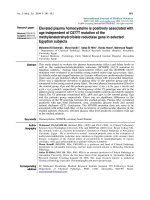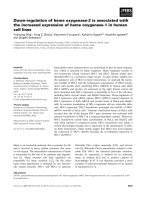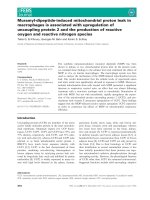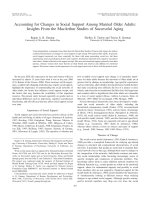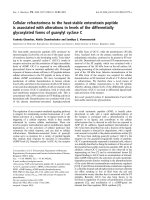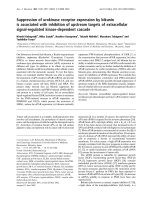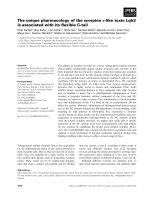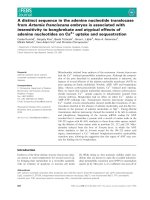Mild cognitive impairment is associated with falls among older adults findings from the irish longitudinal study on ageing (TILDA)
Bạn đang xem bản rút gọn của tài liệu. Xem và tải ngay bản đầy đủ của tài liệu tại đây (503.17 KB, 24 trang )
ÔØ Å ÒÙ× Ö ÔØ
Mild cognitive impairment is associated with falls among older adults:
findings from the Irish Longitudinal Study on Ageing (TILDA)
Stefanos Tyrovolas, Ai Koyanagi, Elvira Lara, Ziggi Santini, Josep Maria Haro
PII:
DOI:
Reference:
S0531-5565(15)30107-8
doi: 10.1016/j.exger.2015.12.008
EXG 9756
To appear in:
Experimental Gerontology
Received date:
Revised date:
Accepted date:
17 August 2015
15 December 2015
16 December 2015
Please cite this article as: Tyrovolas, Stefanos, Koyanagi, Ai, Lara, Elvira, Santini, Ziggi,
Haro, Josep Maria, Mild cognitive impairment is associated with falls among older adults:
findings from the Irish Longitudinal Study on Ageing (TILDA), Experimental Gerontology
(2015), doi: 10.1016/j.exger.2015.12.008
This is a PDF file of an unedited manuscript that has been accepted for publication.
As a service to our customers we are providing this early version of the manuscript.
The manuscript will undergo copyediting, typesetting, and review of the resulting proof
before it is published in its final form. Please note that during the production process
errors may be discovered which could affect the content, and all legal disclaimers that
apply to the journal pertain.
ACCEPTED MANUSCRIPT
1
Mild cognitive impairment is associated with falls among
older adults: findings from the Irish Longitudinal Study on
SC
R
IP
T
Ageing (TILDA)
Stefanos Tyrovolas1,2, Ai Koyanagi1,2, Elvira Lara1,2, Ziggi Santini1, Josep Maria
Parc Sanitari Sant Joan de Déu, Universitat de Barcelona. Fundació Sant Joan de
MA
1
NU
Haro1,2
Déu, Dr Antoni Pujades, 42, SantBoi de Llobregat, Barcelona, 08830, Spain
Instituto de Salud Carlos III, Centro de Investigación Biomédica en Red de Salud
D
2
AC
CE
P
TE
Mental, CIBERSAM, Monforte de Lemos 3-5. Pabellón 11, 28029, Madrid, Spain
Address for Correspondence
Dr. Stefanos Tyrovolas
Parc Sanitari Sant Joan de Déu, Fundació Sant Joan de Déu, CIBERSAM,
Dr. Antoni Pujadas, 42, 08830 – Sant Boi de Llobregat, Barcelona, Spain.
Email:
ACCEPTED MANUSCRIPT
2
Abstract
Introduction: The role of mild cognitive impairment (MCI) on falls among older
T
adults remains under-investigated. The aim of this study was to evaluate the
IP
association between MCI and number of falls or occurrence of non-accidental falls
SC
R
among older adults. Methods: Data from the first wave of the Irish longitudinal Study
on Ageing (TILDA) was analysed. The analytical sample consisted of 5364
NU
individuals aged ≥50 years. MCI was defined as: Montreal Cognitive Assessment
(MoCA) score<26; presence of subjective cognitive complaints; Mini-Mental State
MA
Examination (MMSE) score≥14; and no limitations in activities of daily living
(ADL). Multivariable poisson and logistic regression analyses were conducted to
D
assess the association between MCI and number of falls or presence of non-accidental
TE
falls in the past 12 months. Results: The prevalence of MCI was 10.1%. In the fullyadjusted model, MCI was associated with a higher rate of falls (PR=1.41
CE
P
95%CI=1.05-1.89) and odds for non-accidental falls in the past 12 months (OR=1.67
95%CI=1.07-2.61). Muscle strength and performance indicators, and medical health
AC
conditions were influential factors in the association between MCI and falls but did
not fully explain the association. Conclusion: MCI is related with higher rates of falls
and the occurrence of non-accidental falls among older adults. Future studies are
warranted to clarify the underlying mechanism linking MCI and falls, and to establish
interventions targeting MCI to reduce the risk of falls.
Keywords: Mild cognitive impairment; Falls; Gait speed; Muscle strength
ACCEPTED MANUSCRIPT
3
Introduction
The European commission has recognized population aging as one of the most
T
challenging policy issues of this century in Europe (European Commission 2006).
IP
Advanced age is accompanied by various co-morbidities that affect health status and
SC
R
quality of life including falls (Janssen et al., 2002; Landi et al., 2013; Newman et al.,
2006). Falls are a major health care problem for the elders. Almost 30% of the older
NU
population have been reported to experience a fall accident at least once per year
(Muir et al., 2012). Moreover, falls are associated with a higher risk of loss of
MA
independence, autonomy, and confidence. Falls are one of the major contributors to
the increased need for specialized care and hospitalization among older adults, while
D
it is also associated with higher rates of morbidity, mortality, and institutionalization
TE
(Tinetti et al., 1995; Tinetti and Williams, 1997). Additionally, the cost of falls for the
public health services is high. For example, in the UK, the cost of fall-related
2003).
CE
P
hospitalizations among older adults is almost £1 billion per year (Scuffham et al.,
AC
Various factors such as vision and hearing problems, abnormal blood pressure,
mobility limitation, neuropsychiatric disorders, sarcopenia, and frailty have been
associated with falls (Tinetti et al., 1986; Robbins et al., 1989; Shumway-Cook et al.,
1997; Vellas et al., 1997; Mühlberg and Sieber, 2004). Among neuropsychiatric
disorders, decline in cognitive function has been related with greater risk of falls in
the older population. Recent studies have reported an increased frequency of falls with
lower Mini-Mental State Examination (MMSE) scores (i.e., loss of global cognitive
ability) (Gleason et al., 2009). Impairments in attention (Amboni et al., 2013),
processing speed (Chen et al., 2012), and executive functions (Banich, 2009) have
been proposed as a set of interrelated factors in the pathway between cognitive
ACCEPTED MANUSCRIPT
4
impairment and falls. Based on these previous findings, some researchers have
proposed that fall and injury prevention strategies may benefit from focusing on the
T
early prevention of cognitive decline (Montero-Odasso et al., 2009). In particular, in
IP
recent years, mild cognitive impairment (MCI), which is considered an intermediate
SC
R
state between normal aging and dementia, is gaining further attention from the
viewpoint of prevention of dementia or cognitive decline. However, despite the
potentially important role that cognitive function plays in the occurrence of falls, the
NU
association between MCI and falls among older adults still remain under-investigated
MA
(Delbaere et al., 2012).
Given the rapid aging occurring in Europe, the scarcity of studies on MCI and
D
falls, and a complete lack of studies on this topic from Ireland, the aim of the present
TE
work was to evaluate the associations between MCI and frequency of falls or
occurrence of non-accidental falls in a large, nationally-representative sample of non-
AC
Methods
CE
P
institutionalized older Irish individuals.
Study design and sample
Data from the first wave of the Irish Longitudinal Study on Ageing (TILDA)
was analyzed. The full description of the survey and the sampling procedures can be
found elsewhere (Cronin et al., 2013). Briefly, TILDA was an Irish nationallyrepresentative, cross-sectional study on the economic, health, and social status of the
non-institutionalized population, and was conducted between 2009 and 2010 by
Trinity College in Dublin (Cronin et al., 2013). The sample included a total of 8504
people [individuals aged ≥50 years (n=8175) and their spouses or partners younger
than 50 years (n=329)]. Of these individuals, 5895 completed a health assessment.
ACCEPTED MANUSCRIPT
5
Information was obtained by face-to-face interviews conducted by trained
professionals using Computer Assisted Personal Interviewing (CAPI). The response
T
rate was 62% (Whelan and Savva, 2013).
IP
The Trinity College Dublin approved the design and procedures of the study.
SC
R
Informed consent was obtained from all participants. Individuals were not eligible for
inclusion if they reported a doctor’s diagnosis of dementia. Furthermore, individuals
who were not able to consent personally because of severe cognitive impairment (at
MA
NU
interviewer’s discretion) were also excluded.
Number of falls and the presence of non-accidental falls
The number of falls in the past 12 months was assessed by the question “How many
TE
D
times have you fallen in the last year?” Information on the presence of non-accidental
falls in the past 12 months was assessed by the question “Were any of these falls non-
CE
P
accidental, i.e., with no apparent or obvious reason?” among those who had fallen in
AC
the past 12 months. The answer options were “Yes” or “No”.
Mild cognitive impairment
The case definition of MCI was based on the core criteria outlined by the National
Institute on Aging-Alzheimer´s Association (Albert et al., 2011):
a) Concern about a change in cognition: Subjective cognitive complaints were
assessed by the question “How would you rate your day-to-day memory at present
time?” with answer options: excellent, very good, good, fair, and poor. Those who
replied fair or poor were considered to have subjective cognitive complaints.
b) Objective evidence of impairment in one or more cognitive domains, typically
including memory: Cognitive function was assessed with the Montreal Cognitive
ACCEPTED MANUSCRIPT
6
Assessment (MoCA) (score range: 0–30). This tool has been demonstrated to be
sensitive to mild cognitive deficits when applied in cognitively intact older adults
T
(Kenny et al., 2013), and includes measures of executive function, language, memory,
SC
R
defined as a MoCA score<26 (Freitas et al., 2013).
IP
attention, orientation, calculation, and visuospatial ability. Cognitive impairment was
c) Preservation of independence in functional abilities: The participants were
presented with a list of six basic standard ADLs on dressing, walking, bathing, eating,
NU
getting in or out of bed, and using the toilet (Katz et al., 1963), and were asked if they
MA
have difficulty with these activities. They were also asked to exclude any difficulties
that are expected to last for less than three months. Those who claimed to have
D
difficulty with any of the six abovementioned ADLs were excluded from the analysis.
TE
d) Not demented: Individuals who obtained a score <14 on the MMSE were excluded
CE
P
from the analytical sample (Shigemori et al., 2010).
Sociodemographic and lifestyle characteristics
AC
Sociodemographic and lifestyle characteristics included age (50-59, 60-69, 70-79, ≥80
years), gender, education (primary, secondary, tertiary), wealth, living arrangement
(alone or not), residence [urban (Dublin city or county/another town or city) or rural],
physical activity, and problem drinking. Wealth (financial strain) was assessed by the
statement “shortage of money stops me from doing the things I want to do” with
answer options never, rarely, sometimes, and often. Physical activity was measured
using the short form of the International Physical Activity Questionnaire, which
converts levels of physical activity of various domains into predicted kilocalories
expended per week (Craig et al., 2003). Problem drinking was assessed by the CAGE
ACCEPTED MANUSCRIPT
7
screening test with scores of ≥2 being used as a cut-off for problem drinking
T
(Mayfield et al., 1974).
IP
Muscle strength and performance
SC
R
Handgrip strength and gait speed were considered indicators of muscle strength and
performance respectively (Tyrovolas et al., 2015). Grip strength was assessed using a
dynamometer. Two readings from the dominant hand were taken, and the mean
NU
strength was calculated. Gait speed was measured using the GAITRite portable
MA
electronic walkway system (CIR Systems, Inc., Havertown, PA). Participants walked
at their usual pace along a 4.88-m (16-foot) walkway with an extra 2.5 m at each end
D
to allow for acceleration and deceleration. Gait speed was then calculated as meters
TE
per second and then transformed to centimeters per second.
CE
P
Obesity and medical health conditions
Weight and height were measured using standard procedures. Body mass index (BMI)
AC
was calculated as weight in kilograms divided by height in meters squared. Obesity
was defined as BMI≥30kg/m2. The presence of medical conditions was assessed by
asking the respondents about whether they were ever told by a doctor that they have
angina, arthritis (including osteoarthritis and rheumatism), congestive heart failure,
diabetes or high blood sugar, heart attack (including myocardial infarction and
coronary thrombosis), stroke (cerebral vascular disease), or Parkinson's disease. Heart
disease referred to having at least one of: angina, congestive heart failure, and heart
attack. Depression was measured with the 20-item Center for Epidemiologic Studies
Depression (CES-D) (Radloff et al., 1977) based on symptoms experienced in the past
week, and was defined as a CES-D score of ≥ 16 (Beekman et al., 1997).
ACCEPTED MANUSCRIPT
8
Statistical analysis
A descriptive analysis was conducted to characterize the study sample by the presence
T
of MCI. The differences in sample characteristics by the presence of MCI were tested
IP
by chi-squared tests and student’s t-tests for categorical and continuous variables
SC
R
respectively. Poisson and logistic regression analyses were done with number of falls
and presence of non-accidental falls in the past 12 months as the outcome respectively.
MCI was the main covariate of interest. Since it is possible that the inclusion of
NU
different blocks of control variables in the model affects the association between MCI
MA
and falls in different ways, we conducted hierarchical analyses where three different
models were constructed for each outcome: Model 1 - adjusted for sociodemographic
D
and lifestyle characteristics; Model 2 - adjusted for covariates in model 1 and grip
TE
strength and gait speed; Model 3 - adjusted for covariates in model 2 and obesity and
medical health conditions. All variables were included in the models as categorical
CE
P
variables with the exception of grip strength and gait speed (continous variables). The
selection of the covariates was based on past literature (Muir et al., 2012; Tinetti et al.,
AC
1995; Tinetti et al., 1986; Robbins et al., 1989). In order to assess the influence of
multicolinearity, we calculated the variance inflation factor (VIF) value for each
independent variable. The highest VIF was 2.44, which is much lower than the
commonly used-cut off of 10 (O'Brien RM, 2007), indicating that multicolinearity
was unlikely to be a problem in our analyses. The analyses were done with Stata
version 13.1 (Stata Corp LP, College Station, Texas). In order to generate nationallyrepresentative estimates, in all analyses, the sample weighting and the complex study
design were taken into account with Taylor linearization methods. Prevalence ratios
(PR) and odds ratios (OR) and 95% confidence intervals (95%CI) are reported. The
level of statistical significance was set at P<0.05.
ACCEPTED MANUSCRIPT
9
Results
The analytical sample consisted of 5364 individuals aged ≥50 years with no
T
limitations in ADL and a MMSE score of ≥14. The prevalence of MCI was 10.1%.
IP
Overall, 18.9% had fallen at least once and 4.6% had non-accidental falls in the past
SC
R
12 months. The characteristics of the study participants by MCI status are summarized
in Table 1. The following characteristics were significantly associated with MCI:
NU
older age, lower levels of education, higher levels of financial strain, living alone,
rural residence, low physical activity, weaker hand grip strength, slower gait speed,
MA
obesity, and presence of medical conditions (arthritis, stroke, heart disease, and
depression). The association of MCI and other covariates with number of falls in the
D
past 12 months is shown in Table 2. In the model adjusted for sociodemographic and
TE
lifestyle characteristics (Model 1), MCI was associated with a higher rate of falls 1.51
(95%CI 1.15-1.97). After the addition of hand grip strength and gait speed, the PR
CE
P
(95%CI) became 1.47 (95%CI 1.11-1.95). This association remained significant even
after further adjustment for obesity and other medical health conditions [PR 1.41
AC
(95%CI 1.05-1.89)]. In the fully-adjusted model (Model 3), gender, grip strength, and
arthritis were also significantly associated with falls.
The association of MCI and other covariates with non-accidental falls in the
past 12 months is shown in Table 3. MCI was associated with 1.93 (95%CI 1.282.93) times higher odds for non-accidental falls in the model adjusted for
sociodemographic and lifestyle factors (Model 1). Further adjustment for grip strength
and gait speed (Model 2), or obesity and medical health conditions in addition to grip
strength and gait speed (Model 3) attenuated the ORs [Model 2: OR 1.68 (95%CI
1.09-2.60); Model 3: OR 1.67 (95%CI 1.07-2.61)] when compared to Model 1, but
results were still statistically significant in both Model 2 and 3. In the fully-adjusted
ACCEPTED MANUSCRIPT
10
model (Model 3), apart from MCI, the factors significantly associated with non-
T
accidental falls were financial strain, grip strength, gait speed, and arthritis.
IP
Discussion
SC
R
The present work revealed a strong association between MCI and number of falls or
presence of non-accidental falls in the past 12 months in the older Irish population.
NU
Muscle strength and performance, and health conditions were influential factors in the
association between MCI and falls but did not fully explain the association. While
MA
there is a growing literature on cognitive decline and falls, studies specifically on the
topic of MCI and falls are scarce. To date, a small number of studies (Liu-Ambrose et
D
al., 2008; Borges et al., 2015; Dealbaere et al., 2012; Uemura et al., 2014) have
TE
assessed this association. However, with the exception of one study (Uemura et al.,
2014), the rest had very small sample size and were conducted in limited geographical
CE
P
areas. To the best of our knowledge, this is the first study that examined this
association using a large nationally-representative dataset of the older European
AC
(Irish) population.
Our findings on the association between MCI and falls are in line with
previous studies. For example, Liu-Ambrose et al. (2008), in a sample of 158 older
Canadians, reported that females with MCI had higher physiological risk of falling
and increased postural sway compared to females without MCI. Additionally,
Dealbaere et al. (2012) analyzed a sample of 419 non-demented communitydwelling adults in Sydney, and reported that MCI was associated with a 1.72 (95%CI
1.03-2.89) greater risk for falls. Also, Borges et al. (2015), in a sample of 104
community-dwelling elders in Brazil, showed that the prevalence of falls in MCI was
higher than in cognitively healthy older adults. Finally Uemura et al., (2014) analyzed
ACCEPTED MANUSCRIPT
11
a sample of 4474 community-dwelling older Japanese adults and concluded that MCI
has an effect on fear of falling.
T
Our analysis revealed a consistent association between MCI and the number of
IP
falls or the presence of non-accidental falls in the past 12 months. Furthermore, the
SC
R
inclusion of different blocks of covariates in the model attenuated the association but
even after inclusion of all potentially influential variables, the association between
MCI and falls remained significant. The exact mechanism linking MCI with falls is
NU
unclear but attention deficit, impaired psychomotor processing, problem-solving, and
MA
spatial awareness, which are characteristics associated with MCI, have been reported
to be related with balance control and consequently with falls (Alexander and
D
Hausdorff, 2008). Differences in brain structures between those with and without MCI
TE
have also been reported. For example, individuals with MCI may have reduced
integrity of the posterior regions of the brain, and their medial temporal lobe, insula,
CE
P
and thalamus may constitute of reduced gray matter (Medina et al., 2006). Since these
regions of the brain are known to be associated with attention and balance control
AC
(Zimmerman et al., 2006), individuals with MCI may be more likely to fall due to
impairment in attention and equilibrium.
Apart from MCI, factors such as handgrip strength, gait speed and arthritis,
were also associated with falls. Muscle strength and performance have been reported
to be significant predictors of falls (Mühlberg and Sieber, 2004). Furthermore, an
interrelated pathway among gait speed, balance control, cognitive decline and falls in
older adults has been proposed. In addition, falls commonly occur in patients with
arthritis (Kaz Kaz et al., 2004), and the role of arthritis on the epidemiology of falls
has previously been reported. Since falls are associated with high healthcare
expenditures (Ambrose et al., 2013), the prevention of MCI and other co-morbidities
ACCEPTED MANUSCRIPT
12
may be important to promote healthy aging and minimize disability and their resulting
T
distress and costs.
IP
Strengths and limitations
SC
R
The present study has several strengths. It is one of the few studies that evaluated the
association between MCI and falls (especially with large sample size), while it is also
the first study from Ireland on this topic. In terms of limitations, since some data were
NU
obtained using self-reported measures, reporting-bias may be present. Also, because
MA
the survey was not designed to generate clinical diagnoses for dementia, some
individuals with dementia may have been included in our analytical sample. However,
D
we made use of information on dementia diagnosis obtained from the participant or
TE
family members, and excluded those with MMSE score<14, which is a cut-off for
dementia that has been used previously (Shigemori et al., 2010). Furthermore, there
CE
P
are currently no standard definitions for the identification of MCI and a variety of
definitions have been used in previous studies. In our study, objective cognitive
AC
impairment (one of the MCI criteria) was based on a MoCA score<26 which has been
reported to have high sensitivity and specificity for detecting MCI (Nasreddine et al.,
2005ref). However, as with most population-based studies, a thorough clinical
evaluation to detect MCI was lacking. Next we did not have information on spatial
and temporal aspects of gait (e.g., step length and time). Conducting analyses with
more detailed information could have lead to a better understanding of the association
between MCI and falls. Finally, due to the cross-sectional design, we were unable to
establish causal relationships.
Conclusions
ACCEPTED MANUSCRIPT
13
The present work evaluated the role of MCI on falls among older Irish adults. In view
of rapid population aging accompanied with an increase in the prevalence of cognitive
T
impairment, it is of major interest nowadays to study the negative health outcomes of
IP
cognitive impairment. In our study, the potential importance of early detection and
SC
R
management of MCI to prevent falls among the elderly has been highlighted. Also the
prevention or treatment of arthritis and muscle function decline, which are becoming
increasingly prevalent among the elders, may also constitute effective means for
MA
NU
reducing falls and to promote healthy aging among the older population.
Acknowledgments
D
The authors are particularly grateful to the men and women who participated in the
CE
P
Conflicts of interest
TE
TILDA survey.
AC
The authors report no relationships that could be construed as a conflict of interest.
Source of funding
Stefano Tyrovolas received a scholarship from the Foundation for Education and
European Culture (IPEP) to undertake his post-doctoral research, of which this work
is a part. Ai Koyanagi’s work was supported by the Miguel Servet contract financed
by the CP13/00150 project, integrated into the National R+D+I and funded by the
ISCIII - General Branch Evaluation and Promotion of Health Research - and the
European Regional Development Fund (ERDF-FEDER). Elvira Lara’s work is
supported by the FPU predoctoral grant (FPU13/03573) from the Spanish Ministry of
Education, Culture and Sports. Ziggi Santini’s work has received funding from the
ACCEPTED MANUSCRIPT
14
People Programme (Marie Curie Actions) of the European Union's Seventh
AC
CE
P
TE
D
MA
NU
SC
R
IP
T
Framework Programme FP7/2007 – 2013 under REA grant agreement n° 316795.
ACCEPTED MANUSCRIPT
15
References
Albert MS, DeKosky ST, Dickson D, Dubois B, et al. The diagnosis of mild cognitive
IP
T
impairment due to Alzheimer’s disease: recommendations from the National Institute
SC
R
on Aging-Alzheimer's Association workgroups on diagnostic guidelines for
Alzheimer's disease. Alzheimers Dement. 2011;7:270–279.
A Biol Sci Med Sci. 2008;63;1325–1328.
NU
Alexander NB, Hausdorff JM. Linking thinking, walking, and falling. J Gerontol
Amboni M, Barone P, Hausdorff J M. Cognitive contributions to gait and falls:
MA
evidence and implications. Mov Disord. 2013;28:1520-1533.
D
Ambrose AF, PauG, Hausdorff J. Risk factors for falls among older adults: a review
TE
of the literature. Maturitas. 2013;75:51–61.
Banich MT. Executive function: the search for an integrated account. Curr Dir
CE
P
Psychol Sci. 2009;18:89–94.
Beekman AT, Deeg DJ, Van Limbeek J, Braam AW, et al. Criterion validity of the
AC
Center for Epidemiologic Studies Depression Scale (CES-D): Results from a
community-based sample of older subjects in The Netherlands. Psychol Med. 1997;
27:231-235.
Borges
Sde
M, Radanovic
M, Forlenza
OV.Fear of falling and falls in older adults with mild cognitive impairment
and Alzheimer's disease.
Neuropsychol
Dev
Cogn
B
Aging
Neuropsychol
Cogn. 2015;22:312-21.
Chen TY, Peronto CL, Edwards JD. Cognitive function as a prospective predictor
of falls. J Gerontol B Psychol Sci Soc Sci. 2012;67:720–728.
ACCEPTED MANUSCRIPT
16
Craig CL, Marshall AL, Sjostrom M. International physical activity questionnaire: 12country reliability and validity. Med Sci Sports Exerc. 2003;35:1381-1395.
T
Cronin A, O'Regan C, Finucane C, Kearney PM, et al. Health and aging:
IP
Development of the Irish Longitudinal Study on Ageing health assessment. J Am
SC
R
Geriatr Soc. 2013;61:S269-278.
Delbaere K, Kochan NA, Close JC, Menant JC, Sturnieks DL, et al. Mild cognitive
NU
impairment as a predictor of falls in community-dwelling older people. Am J Geriatr
Psychiatry. 2012;20:845-53.
MA
European commission. The demographic future of Europe – from challenge to
opportunity. (COM(2006)0571), Brussels: EC, 2006.
Montreal Cognitive Assessment:
D
Freitas S, Simões MR, Alves L, Santana I.
TE
validation study for mild cognitive impairment and Alzheimer disease. Alzheimer
Dis Assoc Disord. 2013;27:37-43.
CE
P
Gleason CE, Gangnon RE, Fischer BL, Mahoney JE. Increase risk for falling
associated with subtle cognitive impairment: secondary analysis of a randomized
AC
clinical trial. Dement Geriatr Cogn Disord. 2009;27:557–563.
Janssen I, Heymsfield SB, Ross R. Low relative skeletal muscle mass (sarcopenia) in
older persons is associated with functional impairment and physical disability. J Am
Geriatr Soc. 2002;50:889-896.
Katz S, Ford AB, Moskowitz RW, Jackson BA, et al. Studies of illness in the aged.
The index of ADL: A standardized measure of biological and psychosocial function.
JAMA. 1963;185:914-9.
Kaz Kaz H, Johnson D, Kerry S, Chinappen U, et al. Fall-related risk factors and
osteoporosis in women with rheumatoid arthritis. Rheumatology. 2004;43:1267-71
ACCEPTED MANUSCRIPT
17
Kenny RA, Coen RF, Frewen J, Donoghue OA, et al. Normative values of cognitive
and physical function in older adults: findings from the Irish Longitudinal Study on
T
Ageing. J Am Geriatr Soc. 2013;61:S279-90.
IP
Landi F, Cruz-Jentoft AJ, Liperoti R, Russo A, et al. Sarcopenia and mortality risk in
SC
R
frail older persons aged 80 years and older: results from ilSirenTe Study. Age Ageing.
2013;42:203-209.
older
NU
Liu-Ambrose TY, Ashe MC, Graf P, Beattie BL, et al. Increased risk of falling in
community-dwelling women with mild
impairment.
Phys
MA
Ther. 2008;88:1482-91.
cognitive
Mayfield D, McLeod G, Hall P. The CAGE Questionnaire: Validation of a new
D
alcoholism screening instrument. Am J Psychiatry. 1974;131:1121-1123.
TE
Medina D, DeToledo-Morrell L, Urresta, F, Gabrieli JD, et al. White matter
changes in mild cognitive impairment and AD: a diffusion tensor imaging study.
CE
P
Neurobiol Aging. 2006;27:663–672.
Montero-Odasso
M, Wells
JL, Borrie
MJ, Speechley
M.
AC
Can cognitive enhancers reduce the risk of falls in older people with mild cognitive i
mpairment?
A protocol for
a
randomised controlled double blind trial.
BMC
Neurol. 2009;9:42.
Mühlberg W, Sieber C. Sarcopenia and frailty in geriatric patients: implications for
training and prevention. Z Gerontol Geriatr. 2004;37:2–8.
Muir SW, Gopaul K, Montero Odasso MM. The role of cognitive impairment in fall
risk
among
older
adults:
Ageing. 2012;41:299-308.
a
systematic
review
and
meta-analysis.
Age
ACCEPTED MANUSCRIPT
18
Nasreddine ZS, Phillips NA, Bédirian V, Charbonneau S, et al. The Montreal
Cognitive Assessment, MoCA: a brief screening tool for mild cognitive impairment. J
T
Am Geriatr Soc. 2005;53:695-9.
IP
Newman AB, Kupelian V, Visser M, Simonsick EM, et al. Strength, but not muscle
SC
R
mass, is associated with mortality in the health, aging and body composition study
cohort. J Gerontol A Biol Sci Med Sci. 2006;61:72–77.
NU
O'Brien RM. A caution regarding rules of thumb for variance inflation factors. Qual
Quant. 2007;41:673–690
MA
Radloff LS. The CES-D scale: A self-report depression scale for research in the
general population. Applied Psychological Measurement. 1977;1:385-401.
D
Robbins AS, Rubenstein, L Z, Josephson KR, Schulman BL, et al. Predictors of
TE
falls among elderly people: results of two population-based studies. Arch Intern
Med. 1989;149:1628–1633.
CE
P
Scuffham P, Chaplin S, Legood R. Incidence and costs of unintentional falls in older
people in the United Kingdom. J Epidemiol Community Health. 2003; 57:740-4.
AC
Shigemori K, Ohgi S, Okuyama E, Shimura T, et al. The factorial structure of
the Mini-Mental State Examination (MMSE)
in Japanese dementia patients.
BMC
Geriatr. 2010;10:36.
Shumway-Cook A, Baldwin M, Polissar N L, Gruber W. Predicting the probability
for falls in community-dwelling older adults. Phys Ther. 1997;77:812–819.
Tinetti ME, Doucette J, Claus E, Marottoli R.. Risk factors for serious injury during
falls by older persons in the community. J Am Geriatr Soc. 1995;43:1214–1221.
Tinetti ME, Williams CS. Falls, injuries due to falls, and the risk of admission to a
nursing home. N Engl J Med. 1997;337:1279–1284.
ACCEPTED MANUSCRIPT
19
Tinetti ME, Williams TF, Mayewski R. Fall risk index for elderly patients based on
number of chronic disabilities. Am J Med. 1986;80:429–434.
T
Tyrovolas S, Koyanagi A, Olaya B, Ayuso-Mateos JL, et al. The role of muscle mass
IP
and body fat on disability among older adults: A cross-national analysis. Exp
Uemura
SC
R
Gerontol. 2015;69:27-35.
K, Shimada
H, Makizako
H, Doi
T, et
al.
NU
Effects of mild and global cognitive impairment onthe prevalence of fear of falling in
community-dwelling olderadults. Maturitas. 2014;78:62-6.
MA
Vellas BJ, Wayne SJ, Romero L, Baumgartner RN, et al. One-leg balance is an
important predictor of injurious falls in older persons. J Am Geriatr Soc.
D
1997;45:735–738.
TE
Whelan B, Savva GM. Design and methodology of the Irish Longitudinal Study on
CE
P
Ageing. J Am Geriatr Soc. 2013;61:S265-268.
Zimmerman ME, Brickman AM, Paul RH, Grieve SM, et al. The relationship
between frontal gray matter volume and cognition varies across the healthy adult
AC
lifespan. Am J Geriatr Psychiatry. 2006;14:823–833.
ACCEPTED MANUSCRIPT
20
Table 1 Sample characteristics by presence of mild cognitive impairment
Characteristics
Categories
Mild cognitive
impairment
No
Yes
Overall
50-59
44.7
46.4
29.7
<0.0001
60-69
32.8
32.5
35.5
70-79
17.1
16.0
26.6
≥80
5.4
5.1
8.1
Gender
Female
51.8
52.0
50.2
0.4883
Male
48.2
48.0
49.8
Education
Primary
31.4
28.9
53.3
<0.001
Secondary
46.7
47.6
38.6
Tertiary
21.9
23.4
8.0
Financial strain
Never
22.4
22.2
23.5
0.0017
Rarely
23.2
23.7
18.6
Sometimes 37.4
37.7
34.4
Often
17.1
16.4
23.4
Living alone
No
80.9
81.6
74.5
0.0004
Yes
19.1
18.4
25.5
Residence
Rural
48.0
46.6
60.5
<0.0001
Urban
52.0
53.4
39.5
Physical activity
Low
28.4
27.7
35.5
0.0015
Medium
35.2
35.4
33.1
High
36.4
36.9
31.5
Problem drinking
No
87.1
87.0
87.5
0.8132
Yes
12.9
13.0
12.5
Grip strength (kg)
Mean (SD) 26.7 (10.1) 26.9 (10.1) 25.2 (9.6) 0.0013
Gait speed (cm/s)
Mean (SD) 11.9 (2.5)
12.0 (2.4)
10.9 (2.5) <0.0001
Obesity (BMI ≥30kg/m2)
No
66.4
66.9
61.3
0.0185
Yes
33.6
33.1
38.7
Arthritis
No
75.0
76.0
65.5
<0.0001
Yes
25.0
24.0
34.5
Parkinson's disease
No
99.7
99.7
99.3
0.2018
Yes
0.3
0.3
0.7
Stroke
No
98.7
98.8
97.2
0.0038
Yes
1.3
1.2
2.8
Diabetes
No
93.3
93.6
91.3
0.0657
Yes
6.7
6.4
8.7
Heart disease
No
92.4
92.9
87.5
<0.0001
Yes
7.6
7.1
12.5
Depression
No
92.2
93.4
81.1
<0.0001
Yes
7.8
6.6
18.9
Abbreviation: BMI Body Mass Index
Data are percentage (%) unless otherwise stated.
* P-values were calculated by Chi-square tests and Student's t-tests for categorical and continuous
variables respectively.
AC
CE
P
TE
D
MA
NU
SC
R
IP
T
Age (years)
P-value*
ACCEPTED MANUSCRIPT
21
Table 2 Correlates of number of falls in the past 12 months assessed by multivariable Poisson regression
Characteristics
Categories
Model 1
PR
95%CI
Model 2
PR
95%CI
Model 3
PR
95%CI
Mild cognitive impairment
Age (years)
Yes vs. No
50-59
60-69
70-79
≥80
Female
Male
Primary
Secondary
Tertiary
Never
Rarely
Sometimes
Often
Yes vs. No
Rural
Urban
Low
Medium
High
Yes vs. No
1.51**
1.00
1.07
1.28
1.47
1.00
1.08
1.00
1.06
1.04
1.00
1.27
1.26
1.34*
1.28*
1.00
1.23*
1.00
1.18
0.95
1.11
1.47**
1.00
1.00
1.08
1.13
1.00
1.37*
1.00
1.10
1.12
1.00
1.26
1.24
1.31
1.24*
1.00
1.20
1.00
1.20
0.99
1.10
0.98*
0.97
1.41*
1.00
0.97
1.05
1.07
1.00
1.37*
1.00
1.11
1.09
1.00
1.27
1.23
1.26
1.23
1.00
1.20
1.00
1.21
1.01
1.09
0.98*
0.97
0.99
1.24*
2.45
1.39
1.10
1.02
1.24
Living alone
Residence
[0.96,1.68]
[0.97,1.62]
[1.01,1.78]
[1.04,1.57]
[1.02,1.48]
[0.95,1.48]
[0.76,1.19]
[0.87,1.42]
[1.11,1.95]
T
[0.82,1.23]
[0.81,1.43]
[0.72,1.78]
IP
SC
R
[0.85,1.32]
[0.82,1.31]
CE
P
AC
Problem drinking
Grip strength (kg)
Gait speed (cm/s)
Obesity (BMI ≥30kg/m2)
Arthritis
Parkinson's disease
Stroke
Diabetes
Heart disease
Depression
TE
Physical activity
[0.91,1.29]
NU
Financial strain
[0.87,1.31]
[1.00,1.64]
[0.98,2.20]
MA
Education
D
Gender
[1.15,1.97]
Yes vs. No
Yes vs. No
Yes vs. No
Yes vs. No
Yes vs. No
Yes vs. No
Yes vs. No
Abbreviations: PR Prevalence Ratio; CI Confidence Interval; BMI Body Mass Index
The models are mutually adjusted for all covariates in the respective columns.
Grip strength and gait speed were included in the models as continuous variables.
* p<0.05, ** p<0.01, *** p<0.001
[1.05,1.79]
[0.88,1.38]
[0.87,1.43]
[0.95,1.67]
[0.95,1.60]
[0.98,1.75]
[1.00,1.53]
[1.00,1.46]
[0.96,1.51]
[0.79,1.24]
[0.86,1.42]
[0.97,1.00]
[0.92,1.02]
[1.05,1.89]
[0.79,1.19]
[0.80,1.38]
[0.68,1.69]
[1.04,1.81]
[0.88,1.39]
[0.85,1.41]
[0.95,1.69]
[0.94,1.61]
[0.93,1.70]
[0.98,1.53]
[0.99,1.45]
[0.97,1.52]
[0.80,1.27]
[0.85,1.39]
[0.97,1.00]
[0.92,1.03]
[0.81,1.19]
[1.02,1.53]
[0.55,10.97]
[0.72,2.71]
[0.84,1.46]
[0.70,1.48]
[0.86,1.77]
ACCEPTED MANUSCRIPT
22
Table 3 Correlates of non-accidental falls in the past 12 months assessed by multivariable logistic regression
Model 1
Model 2
Model 3
Characteristics
Categories
OR
95%CI
OR
95%CI
OR
95%CI
Mild cognitive impairment
Age (years)
Yes vs. No
50-59
60-69
70-79
≥80
Female
Male
Primary
Secondary
Tertiary
Never
Rarely
Sometimes
Often
Yes vs. No
Rural
Urban
Low
Medium
High
Yes vs. No
1.93**
1.00
1.30
1.78*
2.35*
1.00
0.62**
1.00
1.25
0.89
1.00
1.49
1.46
1.88*
1.30
1.00
1.33
1.00
1.17
0.83
1.09
[1.28,2.93]
1.68*
1.00
1.13
1.12
0.97
1.00
1.22
1.00
1.41
1.08
1.00
1.44
1.39
1.81*
1.23
1.00
1.30
1.00
1.22
0.90
1.09
0.95***
0.90**
[1.09,2.60]
1.67*
1.00
1.04
1.05
0.86
1.00
1.22
1.00
1.41
1.01
1.00
1.48
1.39
1.83*
1.24
1.00
1.30
1.00
1.19
0.90
1.11
0.95***
0.90**
0.90
1.58**
3.41
1.45
1.09
0.75
0.82
[1.07,2.61]
Physical activity
[0.95,1.88]
[0.81,1.69]
[0.56,1.23]
[0.69,1.72]
IP
T
[0.77,1.66]
[0.67,1.85]
[0.43,2.23]
[0.78,1.91]
SC
R
NU
[0.95,2.35]
[0.96,2.22]
[1.16,3.04]
[0.89,1.91]
Yes vs. No
Yes vs. No
Yes vs. No
Yes vs. No
Yes vs. No
Yes vs. No
Yes vs. No
AC
Problem drinking
Grip strength (kg)
Gait speed (cm/s)
Obesity (BMI ≥30kg/m2)
Arthritis
Parkinson's disease
Stroke
Diabetes
Heart disease
Depression
[0.83,1.91]
[0.58,1.39]
MA
Living alone
Residence
D
Financial strain
TE
Education
[0.45,0.86]
CE
P
Gender
[0.89,1.89]
[1.12,2.82]
[1.18,4.71]
Abbreviations: OR Odds Ratio; CI Confidence Interval; BMI Body Mass Index
The models are mutually adjusted for all covariates in the respective columns.
Grip strength and gait speed were included in the models as continuous variables.
* p<0.05, ** p<0.01, *** p<0.001
[0.91,2.17]
[0.69,1.71]
[0.91,2.28]
[0.91,2.12]
[1.12,2.94]
[0.83,1.80]
[0.92,1.85]
[0.84,1.77]
[0.61,1.34]
[0.68,1.74]
[0.92,0.97]
[0.84,0.96]
[0.70,1.54]
[0.63,1.75]
[0.36,2.04]
[0.76,1.95]
[0.91,2.19]
[0.64,1.60]
[0.93,2.37]
[0.89,2.16]
[1.11,3.02]
[0.84,1.84]
[0.92,1.85]
[0.81,1.73]
[0.60,1.34]
[0.70,1.77]
[0.93,0.98]
[0.84,0.97]
[0.63,1.29]
[1.15,2.16]
[0.73,15.99]
[0.56,3.74]
[0.63,1.87]
[0.39,1.44]
[0.49,1.37]
ACCEPTED MANUSCRIPT
Highlights
CE
P
TE
D
MA
NU
SC
R
IP
T
The prevalence of mild cognitive impairment was 10% in the Irish older population
Mild cognitive impairment is related with higher rates of falls among older adults.
Mild cognitive impairment is related with the occurrence of non-accidental falls.
AC
23
